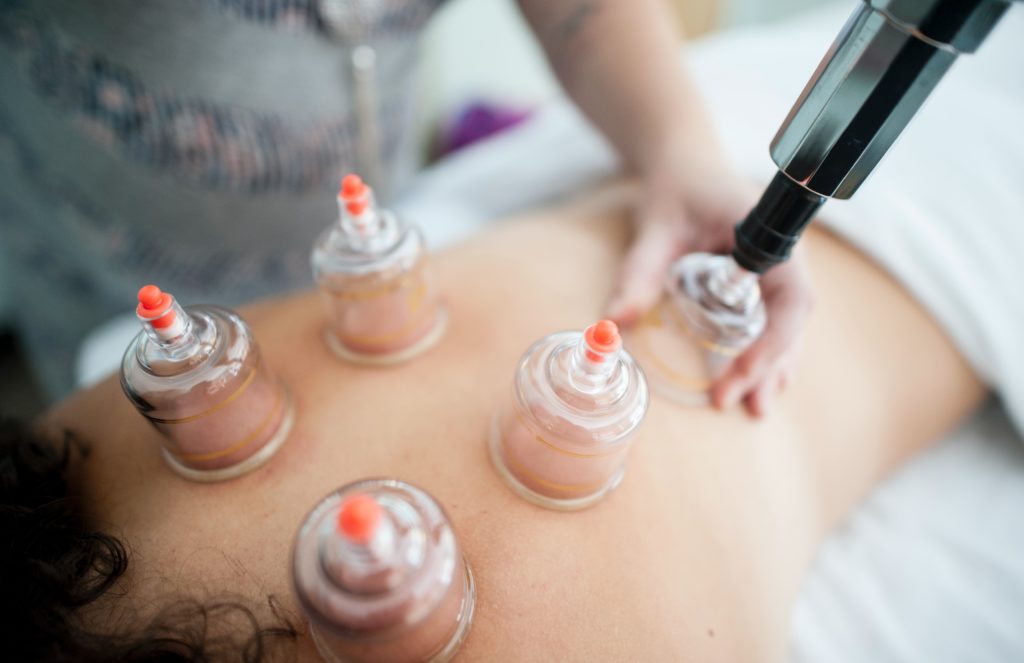Cupping therapy is a very ancient therapy used to help patients find relief from several conditions and illnesses. Physical therapy clinics provide cupping services after proper diagnosis of your disease. A therapy that goes back to ancient Egyptian, Chinese and Middle Eastern cultures and is oldest known in medical textbooks is cupping therapy. It has been practised in Chinese medicine for thousands of years to heal pain, tissue stiffness, and respiratory problems.

Cupping service is offered to patients to address issues like muscle, skin, myofascial areas with decreased mobility, tendonitis, bursitis, carpal turner syndrome, muscle stiffness, arthritis, headache and back pain.
Cupping procedure
In the therapy session, special cups are used on your skin to create a suction. Cups made out of glass, silicone, bamboo or earthenware are used. Cups are placed on the skin, creating a vacuum by suctioning out the air. The underlying tissue is sucked partway into the cup. The whole purpose is to help circulation, relieve pain, and pull out toxins. You might feel a tight sensation in the area where the cup is placed. Although, some people describe the feeling as relaxing and soothing. It is not painful. There are two methods of cupping service, wet and dry. It might use a flammable liquid, herbs, or paper in a cup and set it on fire. As the fire goes out, the cup is kept upside down on your skin. Vacuum is created as the inside air cools down. By these, your blood vessels expand, and your skin becomes reddish. For three minutes, the cup is left there on your skin.
Today, cupping therapist practitioners have developed a newer and safer version of cupping using a rubber pump instead of fir to create the vacuum. Therapists use silicone cups; they can also be moved from place to place on your skin for a massage-like effect. Have a look at a few of the methods:
Dry Cupping: Particularly used in physical therapy as a form of soft tissue mobilization by using myofascial decompression to release tissue restrictions in the skin and muscles. It is assumed to increase local circulation in the cupped section. Cupping therapy leaves round dark marks that look somewhat like bruises on your skin.
Wet cupping: A mild suction is created by leaving a cup for about 3 minutes. It is then removed, and a small scalpel is used to make light, tiny cuts on your skin. Further, a second suction draws out a small amount of blood. Antibiotic ointment and bandages are given after the procedure to prevent infection. Your skin should look normal within ten days.
Needle cupping: The therapist first inserts acupuncture needles and then puts cups over them. It’s usually used to heal knee and elbow joints.
Fixed and moving to cup: As the name suggests, fixed is where cups are placed and left without moving them. In the selected place, an oil massage or cream rub is given with moving to the cup. The cups are placed on the section to be healed or cured, then the therapist will slide the cups around the body, primarily on your back.
What is treated by Cupping service?
Some people believe that cupping can help in relieving stress, pain, allergies, fatigue, flu, colds, back pain, anxiety, muscle aches, fever or red itchy skin conditions. It can also help in removing toxins from the body. Blood flow is stimulated as one of the benefits of cupping therapy.
Further, The British Cupping Society believes that it cupping can treat blood disorders like anaemia and haemophilia, rheumatic disease like arthritis and fibromyalgia, fertility and gynaecological disorders, skin problems like Dermatitis and acne, bronchial obstruction from sensitivities and asthma, high blood stress, anxiety and distress, migraines, and even varicose arteries.
Side effects of Cupping Therapy
You should take cupping service from a trained and experienced therapist. The main side effect of cupping is you get circle-shaped bruises or redness that are potentially left after the session. The visibility varies from 3-7 days, and it depends on the area cupped.
Cupping therapy also creates a Vasovagal Response, a temporary failure of the brain to blood pressure and heart rate. It happens because of fever, anxiety, blood loss, pain, trauma, extreme exertion, prolonged static, emotional or physical stress, or any unpleasant sight, smell or sound.
Cautions
If you are the one who is used to bleed easily or can’t stop bleeding, have skin ulcers or edema, then you should avoid cupping services. Even it’s unwise to cup over large blood vessels. Pregnant women should not use cupping on their abdomen and lower back. Start slowly and incrementally increase the intensity of suction and when the cups are left on the skin.
Make sure whenever you take cupping service as a treatment for any of your related conditions, consult a therapist who is trained and experienced in providing cupping therapy.
